Pleistocene Palaeoart of the Americas
Abstract
:1. Introduction
2. North America
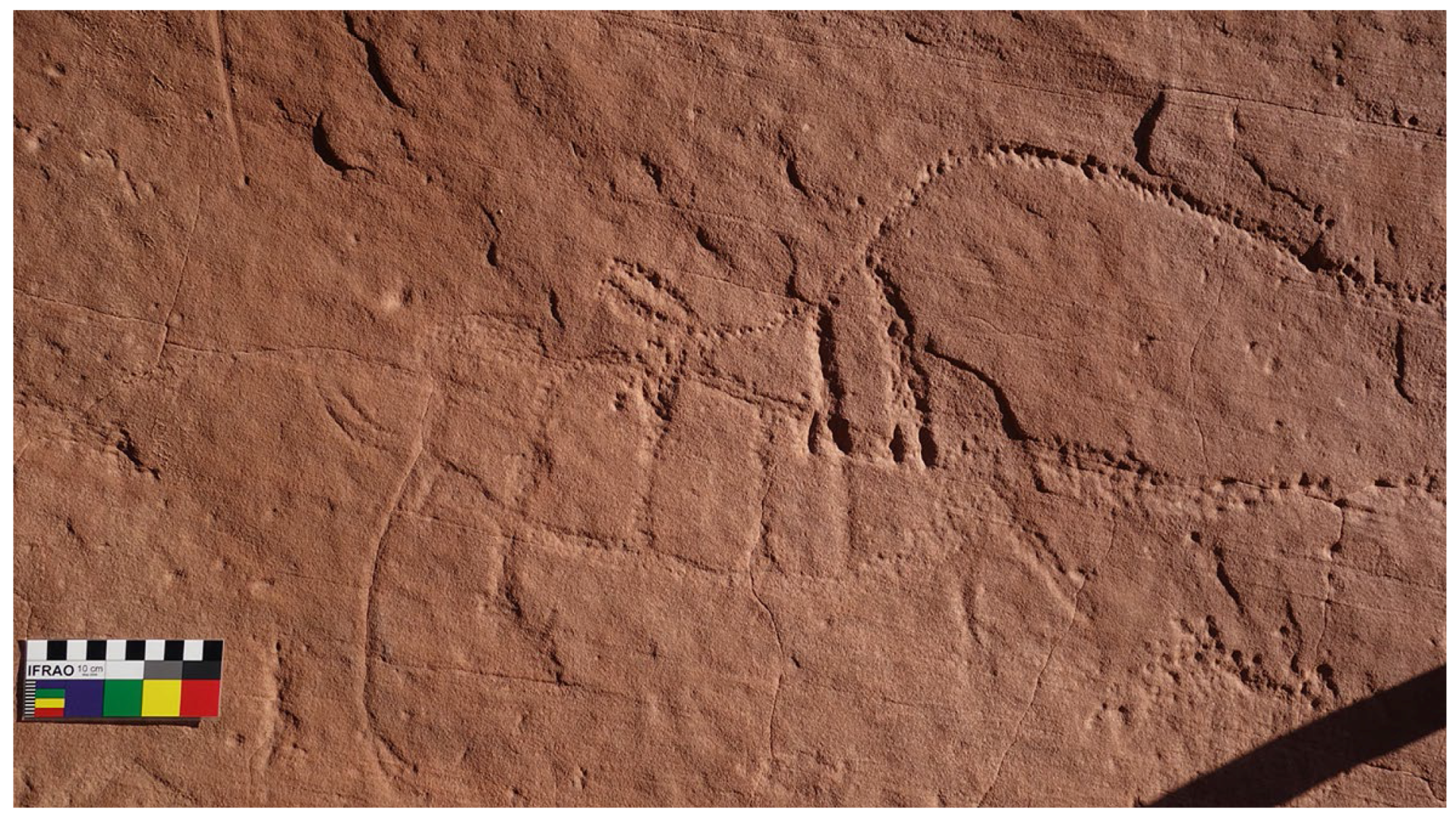
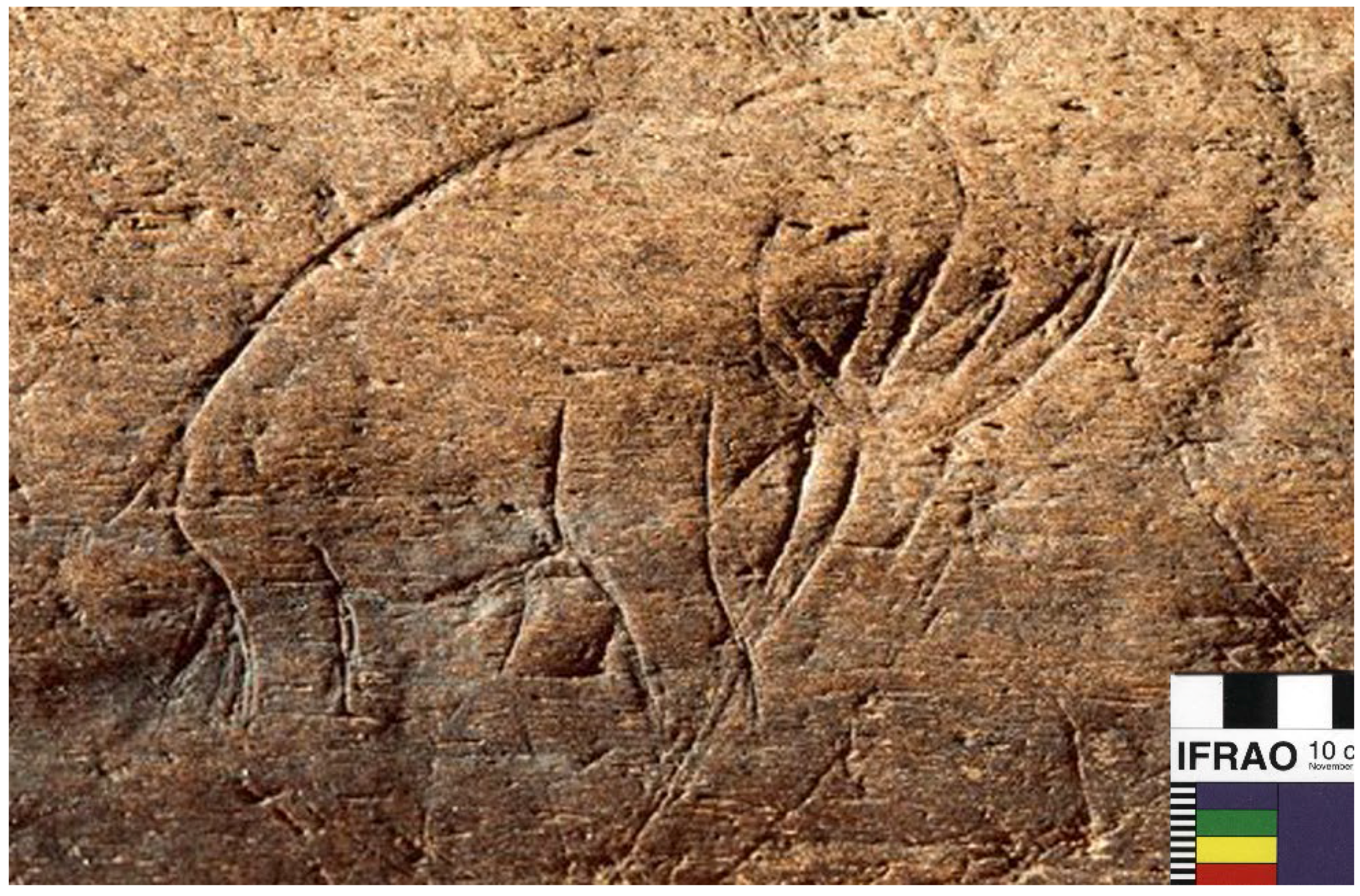
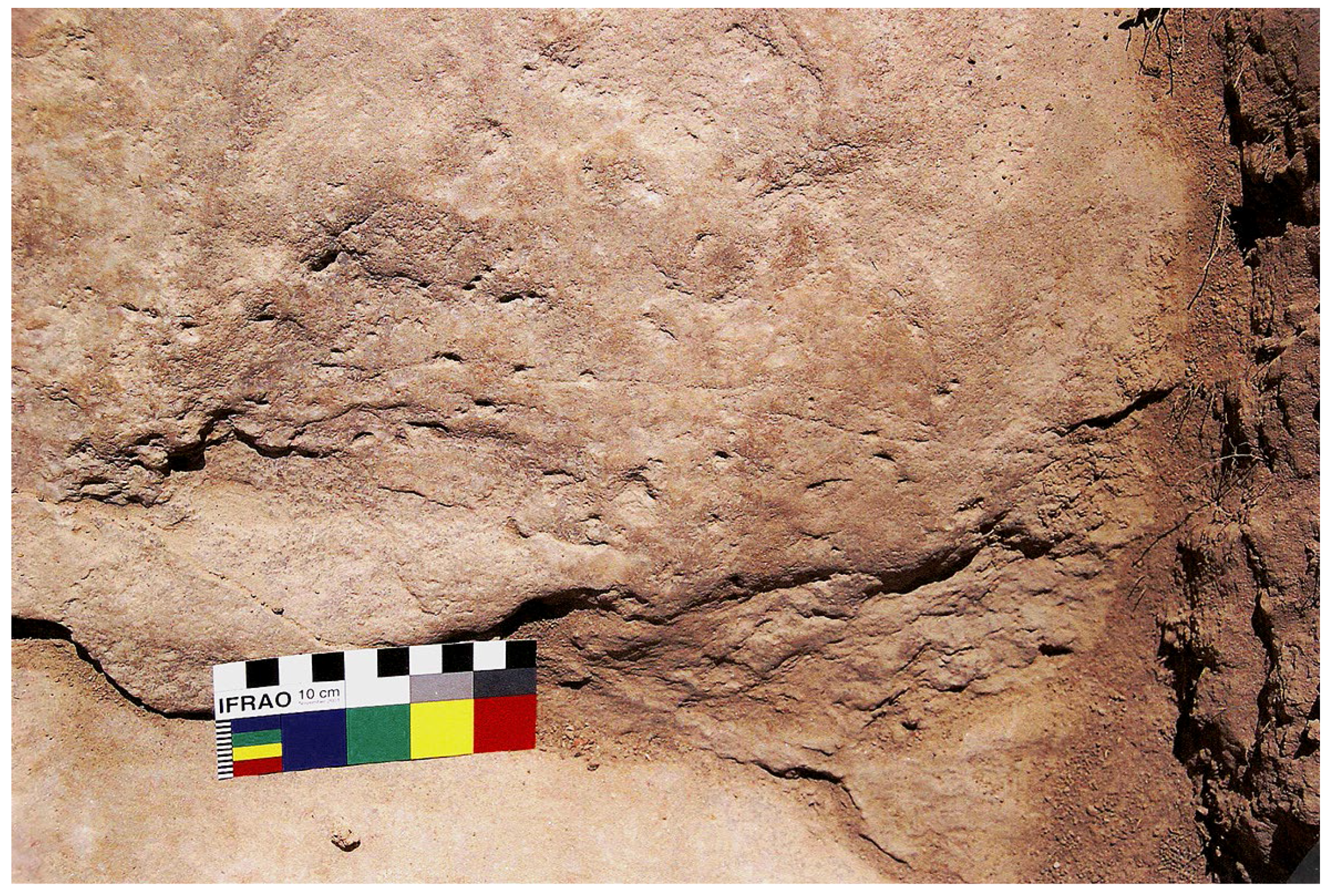
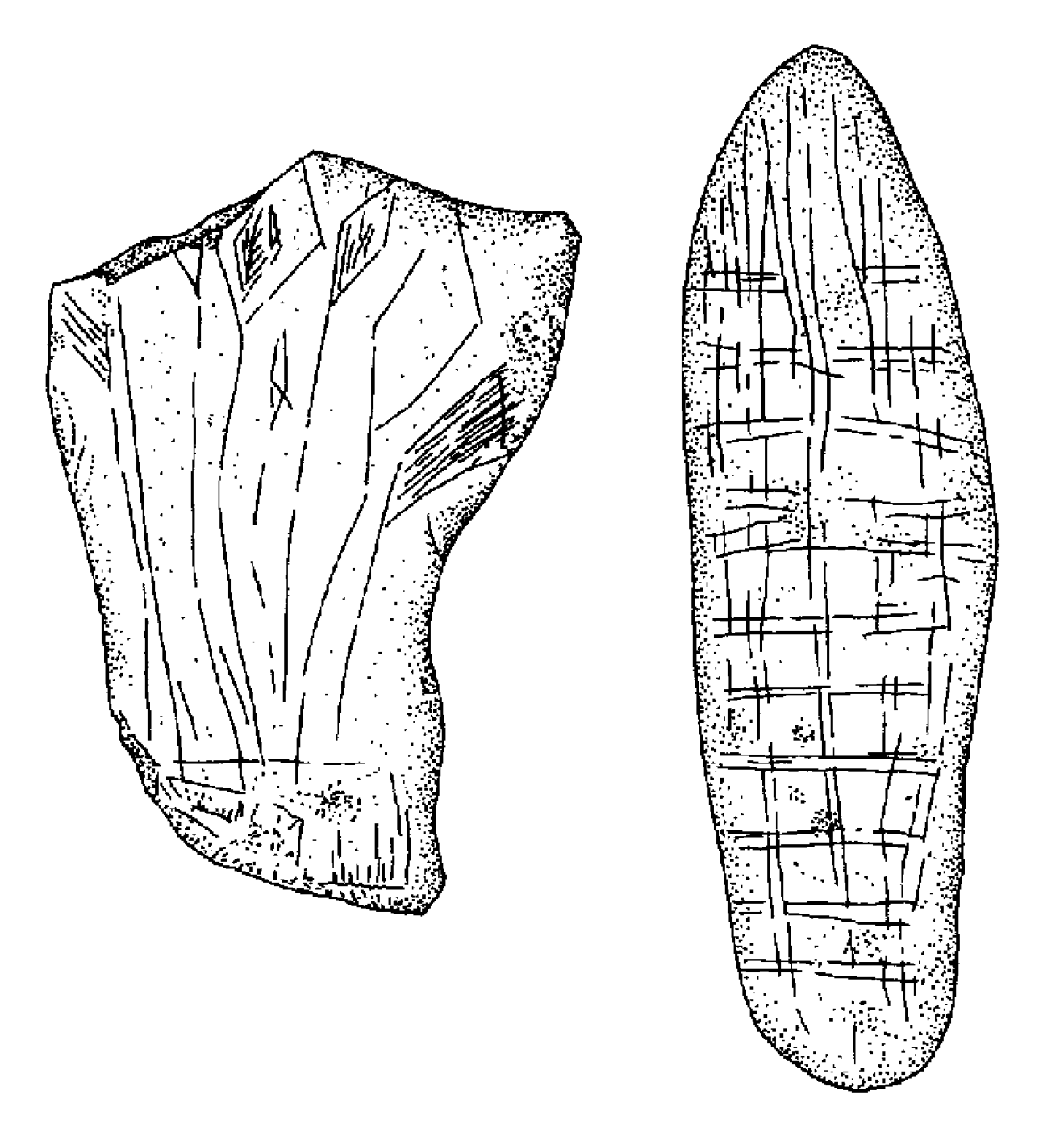
3. South America
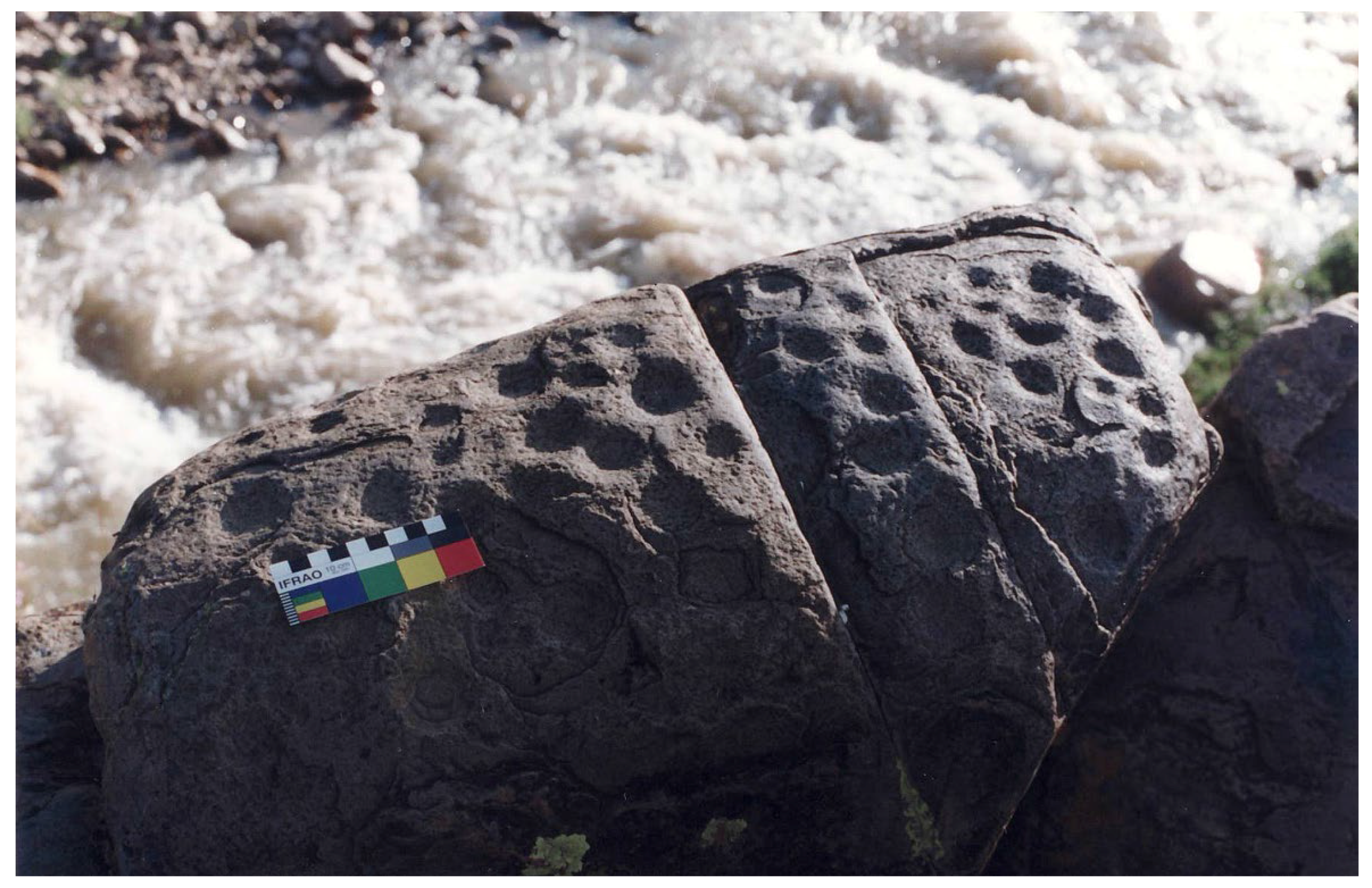
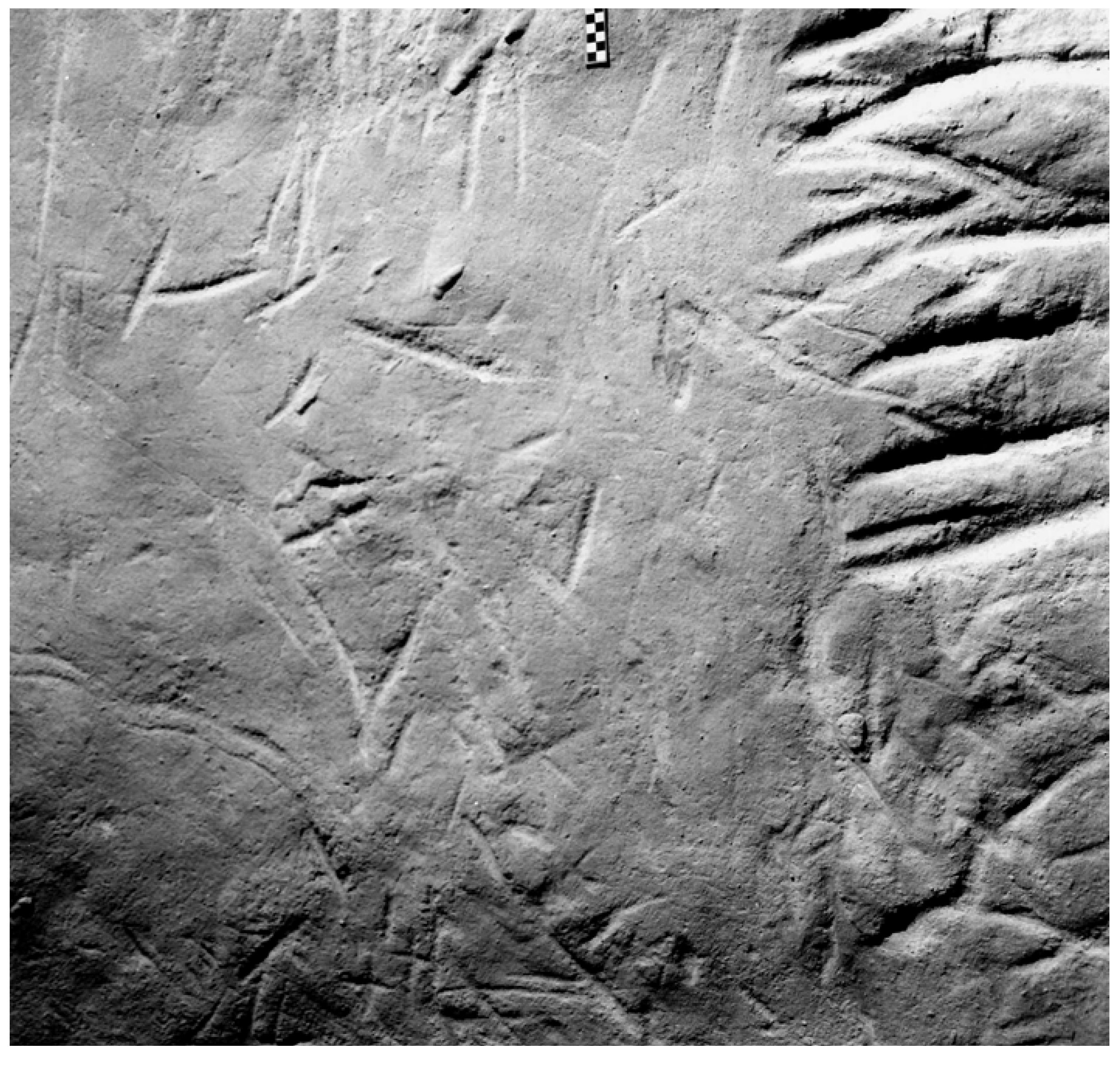
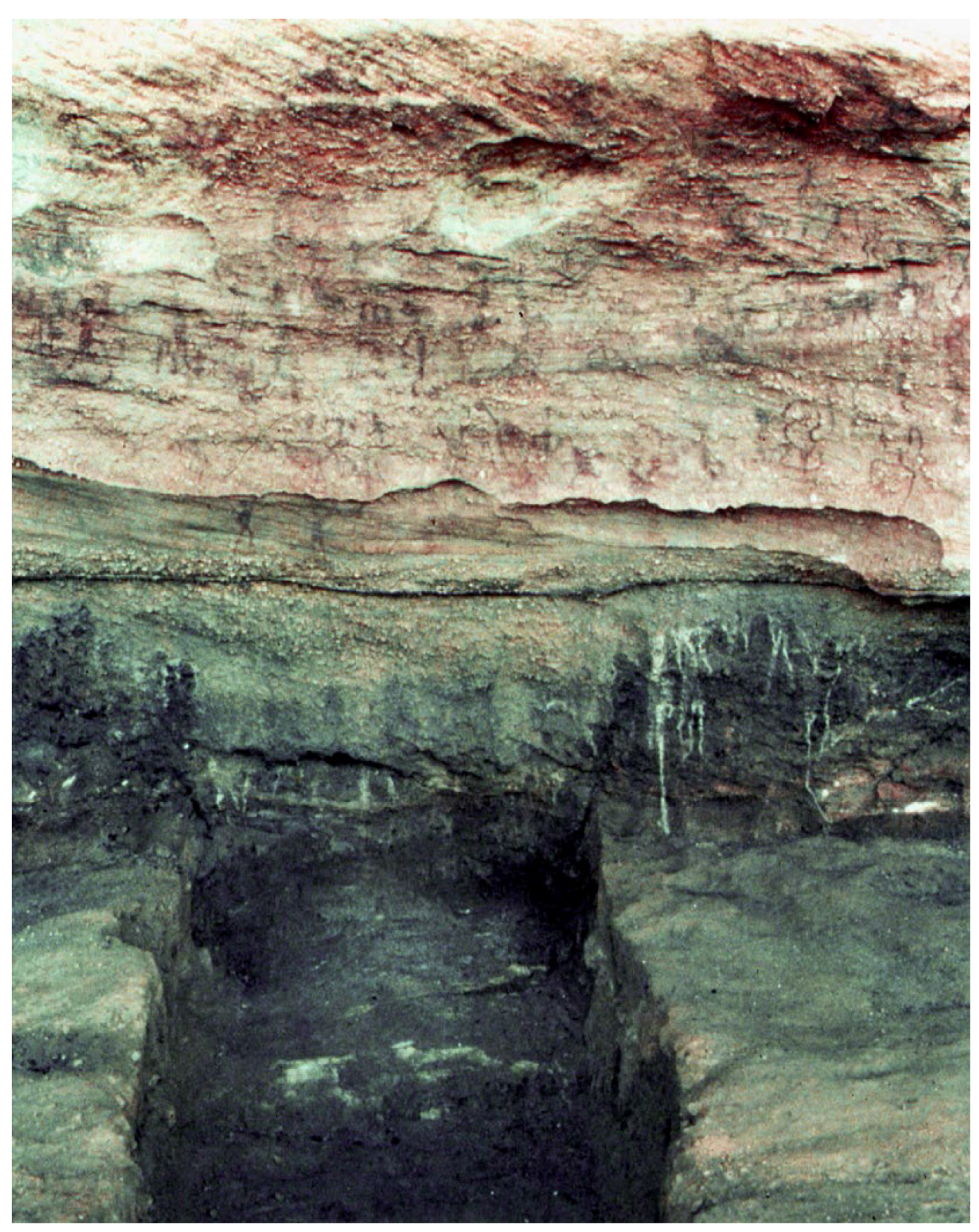
4. Discussion
Conflicts of Interest
References
- P.A. Armstrong. The Piasa, or the Devil among the Indians. Morris, IL, USA: E. B. Fletcher, 1887. [Google Scholar]
- G.L. Badam, and S.N. Rajaguru. “Comment on ‘Toba ash on the Indian subcontinent and its implications for the correlation of Late Pleistocene alluvium’ by S.K. Acharyya and P.K. Basu.” Quatern. Res. 41 (1994): 398–399. [Google Scholar] [CrossRef]
- P.G. Bahn. “Pleistocene images outside Europe.” Proc. Prehist. Soc. 57 (1991): 91–102. [Google Scholar] [CrossRef]
- F.A. Barnes, and M. Pendleton. “Canyon Country prehistoric Indians.” In Their Cultures, Ruins, Artifacts, and Rock Art. Salt Lake City, UT, USA: Wasatch, 1979. [Google Scholar]
- M.A. Baumhoff. “The evolution of Pomo Society.” J. Calif. Great Basin Anthrop. 2 (1980): 175–185. [Google Scholar]
- P.B. Beaumont, and R.G. Bednarik. “Tracing the emergence of palaeoart in sub-Saharan Africa.” Rock Art Res. 30 (2013): 33–54. [Google Scholar]
- W. Beck, D.J. Donahue, A.J.T. Jull, G. Burr, W.S. Broecker, G. Bonani, I. Hajdas, and E. Malotki. “Ambiguities in direct dating of rock surfaces using radiocarbon measurements.” Science 280 (1998): 2132–2135. [Google Scholar] [CrossRef]
- R.G. Bednarik. “Comment on M.F. Nobbs and R.I. Dorn, ‘Age determinations for rock varnish formation within petroglyphs: Cation-ratio dating of 24 motifs from the Olary region, South Australia’.” Rock Art Res. 5 (1988): 124–139. [Google Scholar]
- R.G. Bednarik. “El arte rupestre Boliviano visto desde el exterior.” SIARB Boletín 2 (1988): 22–28. [Google Scholar]
- R.G. Bednarik. “On the Pleistocene settlement of South America.” Antiquity 63 (1989): 101–111. [Google Scholar]
- R.G. Bednarik. “Art origins.” Anthropos 89 (1994): 169–180. [Google Scholar]
- R.G. Bednarik. “The Pleistocene art of Asia.” J. World Prehist. 8 (1994): 351–375. [Google Scholar] [CrossRef]
- R.G. Bednarik. “A taphonomy of palaeoart.” Antiquity 68 (1994): 68–74. [Google Scholar]
- R.G. Bednarik. “Archaeological potentials at the Parowan Gap Site, Utah.” In Rock Art Studies in the Americas. Edited by J. Steinbring. Papers presented to Symposium B, In Proceedings of the First AURA Congress, Darwin, September 1988; Oxbow Monograph 45; Oxford, UK: Oxbow Books, 1995, pp. 93–97. [Google Scholar]
- R.G. Bednarik. “Metamorphology: In lieu of uniformitarianism.” Oxf. J. Arch. 14 (1995): 117–122. [Google Scholar] [CrossRef]
- R.G. Bednarik. “Maritime navigation in the Lower and Middle Palaeolithic.” C. R. l’Académie Sci. Paris 328 (1999): 559–563. [Google Scholar] [CrossRef]
- R.G. Bednarik. “Age estimates for the petroglyph sequence of Inca Huasi, Mizque, Bolivia.” Andean Past 6 (2000): 277–287. [Google Scholar]
- R.G. Bednarik. “The earliest evidence of palaeoart.” Rock Art Res. 20 (2003): 89–135. [Google Scholar]
- R.G. Bednarik. “Seafaring in the Pleistocene.” Cambr. Arch. J. 13 (2003): 41–66. [Google Scholar] [CrossRef]
- R.G. Bednarik. Rock Art Science: The Scientific Study of Palaeoart. New Delhi, India: Aryan Books International, 2007. [Google Scholar]
- R.G. Bednarik. “Pleistocene rock art in Australia.” Anthropos 105 (2010): 3–12. [Google Scholar]
- R.G. Bednarik. The Human Condition. New York, NY, USA: Springer, 2011. [Google Scholar]
- R.G. Bednarik. “Pleistocene palaeoart of Africa. Special issue ‘World rock art’.” Arts 2 (2013): 6–34. [Google Scholar] [CrossRef]
- R.G. Bednarik. “Pleistocene palaeoart of Asia. Special issue ‘World rock art’.” Arts 2 (2013): 46–76. [Google Scholar] [CrossRef]
- R.G. Bednarik. “Proboscidean petroglyphs in the USA.” Int. Newsl. Rock Art 67 (2013): 1–7. [Google Scholar]
- R.G. Bednarik. “Brazil in the context of early South American rock art.” AURA Newsl. 30 (2013): 1–4. [Google Scholar]
- R.G. Bednarik, G. Kumar, A. Watchman, and R.G. Roberts. “Preliminary results of the EIP Project.” Rock Art Res. 22 (2005): 147–197. [Google Scholar]
- R.G. Bednarik, L.R. Querejazu, and D. Comacho. “The Kalatrancani petroglyph complex, central Bolivia.” Rock Art Res., 2015, in press. [Google Scholar]
- F.P. Beierle. Man, Dinosaur, and History. Prosser, WA, USA: Perfect Printing, 1980. [Google Scholar]
- P.R. Bierman, and A.R. Gillespie. “Accuracy of rock-varnish chemical analyses: Implications for cation-ratio dating.” Geology 19 (1991): 196–199. [Google Scholar] [CrossRef]
- P.R. Bierman, A.R. Gillespie, and S. Kuehner. “Precision of rock-varnish chemical analyses and cation-ratio ages.” Geology 19 (1991): 135–138. [Google Scholar] [CrossRef]
- L. Butt, and E. Lyons. Dinosaurs Unleashed. Montgomery, AL, USA: Apologetics Press, 2004. [Google Scholar]
- S.D. Chaffee, M. Hyman, and M. Rowe. “AMS 14C dating of rock paintings.” In Time and Space: Dating and Spatial Considerations in Rock Art Research. Edited by J. Steinbring, A. Watchman, P. Faulstich and P.S.C. Taçon. Occasional AURA Publication 8; Melbourne, Australia: Australian Rock Art Research Association, 1993, pp. 67–73. [Google Scholar]
- C.W. Clewlow, R.A. Cowan, J.F. O’Connell, and C. Benemann. Colossal Heads of the Olmec Culture. Berkeley, CA, USA: Contributions of the University of California Archaeological Research Facility 4, 1967. [Google Scholar]
- C.W. Clewlow Jr., and S.K. Uchitel. “Paleoindian rock art? The Yellow Rock Canyon petroglyh.” In Archaeology without Limits. Papers in Honor of Clement W. Meighan. Edited by B.D. Dillan and M.A. Boxt. Lancaster, CA, USA: Labyrinthos, 2005, pp. 35–44. [Google Scholar]
- M.B. Collins. “The Gault Site, Texas, and Clovis research.” Athena Rev. 3 (2002): 31–42, 100–101. [Google Scholar]
- M.B. Collins, T.R. Hester, and P.J. Headrick. “Engraved cobbles from the Gault Site, central Texas.” Curr. Res. Pleist. 9 (1992): 3–4. [Google Scholar]
- M.B. Collins, T.R. Hester, D. Olmstead, and P.J. Headrick. “Engraved cobbles from early archaeological contexts in central Texas.” Curr. Res. Pleist. 8 (1991): 13–15. [Google Scholar]
- E.A. Crivelli Montero, and M.M. Fernández. “Palaeoindian bedrock petroglyphs at Epullán Grande Cave, northern Patagonia, Argentina.” Rock Art Res. 13 (1996): 112–117. [Google Scholar]
- S. Dewdney, and E. Kidd. Indian Rock Paintings of the Great Lakes. Toronto, ON, Canada: University of Toronto Press, 1967. [Google Scholar]
- T.D. Dillehay, and M.B. Collins. “Early cultural evidence from Monte Verde in Chile.” Nature 332 (1988): 150–152. [Google Scholar] [CrossRef]
- R.I. Dorn. “A change of perception.” Pintura 23 (1996): 10–11. [Google Scholar]
- R.I. Dorn. “Uncertainties in 14C ages for petroglyphs from the Olary province, South Australia.” Arch. Ocean. 31 (1996): 214–215. [Google Scholar]
- R.I. Dorn. “Constraining the age of the Côa valley (Portugal) engravings with radiocarbon dating.” Antiquity 71 (1997): 105–115. [Google Scholar]
- R.I. Dorn, and D.S. Whitley. “Chronometric and relative age determination of petroglyphs in the western United States.” Ann. Ass. Am. Geogr. 74 (1984): 308–322. [Google Scholar] [CrossRef]
- P. Ellenberger, D.J. Mossman, A.D. Mossman, and M.G. Lockley. “Bushman cave paintings of ornithopod dinosaurs: Paleolithic trackers interpret Early Jurassic footprints.” Ichnos 12 (2005): 223–226. [Google Scholar] [CrossRef]
- J.T. Faith, and T.A. Surovell. “Synchronous extinction of North America’s Pleistocene mammals.” Proc. Natl. Acad. Sci. USA 106 (2009): 20641–20645. [Google Scholar] [CrossRef] [PubMed]
- C. Gay. “Olmec hieroglyphic writing.” Archaeology 26 (1973): 278–288. [Google Scholar]
- W.J. Gibbons, and K. Hovind. Claws, Jaws, and Dinosaurs. Pensacola, FL, USA: CSE Publications, 1999. [Google Scholar]
- M.L. Gillam, and L.D. Wakeley. “Are Utah’s Sand Island ‘mammoths’ Late Pleistocene? A geologic view.” In Proceedings of the IFRAO-ARARA International Rock Art Conference, Albuquerque, NM, USA, 26–31 May 2013.
- L.M. Gould. “The Moab mastodon pictograph.” Sci. Mon. 41 (1935): 378–379. [Google Scholar]
- C. Grant. Rock Art of the American Indian. New York, NY, USA: Promontory Press, 1967. [Google Scholar]
- T. Grieder. Origins of Pre-Columbian Art. Austin, TX, USA: University of Texas Press, 1982. [Google Scholar]
- J.B. Griffin, D.J. Meltzer, B.D. Smith, and W.C. Sturtevant. “A mammoth fraud in science.” Am. Antiq. 53 (1988): 578–582. [Google Scholar] [CrossRef]
- D.C. Grove. “Olmec monuments: Mutilations as a clue to meaning.” In The Olmec and Their Neighbors. Edited by E.P. Benson. Washington, DC, USA: Dumbarton Oaks, 1981, pp. 49–68. [Google Scholar]
- D.C. Grove. “Miscellaneous bedrock and boulder carvings.” In Ancient Chalcatzingo. Edited by D.C. Grove. Austin, TX, USA: University of Texas Press, 1987, pp. 159–170. [Google Scholar]
- N. Guidon. “Les premières occupations humaines de l’aire archéologique de Sao Raimundo Nonato - Piauí - Brésil.” L’Anthropologie 88 (1984): 263–271. [Google Scholar]
- N. Guidon, and G. Delibrias. “Carbon-14 dates point to man in the Americas 32,000 years ago.” Nature 321 (1986): 769–771. [Google Scholar] [CrossRef]
- R.F. Heizer, and M.A. Baumhoff. Prehistoric Rock Art of Nevada and Eastern California. Berkeley, CA, USA: University of California Press, 1962. [Google Scholar]
- S. Hubbard. Discoveries Relating to Prehistoric Man by the Doheny Scientific Expedition in the Hava Supai Canyon, Northern Arizona, with Supplement. Oakland, CA, USA: Oakland Museum, 1927. [Google Scholar]
- D. Isaacs. Dragons or Dinosaurs? Creation or Evolution? Alachua, FL, USA: Bridge-Logos, 2010. [Google Scholar]
- A.J. Jelinek. “Perspectives from the Old World on the habitation of the New.” Am. Antiq. 57 (1992): 345–347. [Google Scholar] [CrossRef]
- R.L. Kaldenberg. “Possible proboscidean petroglyph found at China Lake Naval Air Weapons Station.” Curr. Res. Pleist. 22 (2005): 51–53. [Google Scholar]
- W.J. Kennedy. “A comparison of certain Costa Rica petroglyph designs with those of adjacent areas.” In Proceedings of the Fourth International Congress for the Study of the Precolumbian Cultures of the Lesser Antilles, Saint Lucia, 1973; Saint Lucia, Castries: Archaeological and Historical Society, 1973. [Google Scholar]
- J.C. Kraft, and R.A. Thomas. “Early man at Holly Oak, Delawere.” Science 192 (1976): 756–761. [Google Scholar] [CrossRef] [PubMed]
- G. Kumar. “Daraki-Chattan: A Palaeolithic cupule site in India.” Rock Art Res. 13 (1996): 38–46. [Google Scholar]
- T.N. Layton. “Stalking elephants in Nevada.” West. States Folkl. Soc. 35 (1976): 250–257. [Google Scholar] [CrossRef]
- E. Lyons, and L. Butt. The Dinosaur Delusion. Montgomery, AL, USA: Apologetics Press, 2008. [Google Scholar]
- E. Malotki, and H.D. Wallace. “Columbian mammoth petroglyphs from the San Juan River near Bluff, Utah, United States.” Rock Art Res. 28 (2011): 143–152. [Google Scholar]
- E. Malotki, and D.E. Weaver. Stone Chisel and Yucca Brush: Colorado Plateau Rock Art. Walnut, CA, USA: Kiva Publishing, 2002. [Google Scholar]
- J. Marquette. Recit des voyages det des ecouvertes R. Père Jacques Marquette de la Compagnie de Jesus, en l’année 1673 et aux Suivantes; la continuation de ses voyages par le R.P. Claude Alloüez, le journal autographe du P. Marquette en 1674 & 1675. Albany, NY, USA: Weed, Parsons & Cie, 1855. [Google Scholar]
- A. Mayor, and W.A.S. Sarjeant. “The folklore of footprints in stone: From classical antiquity to the present.” Ichnos 8 (2001): 143–163. [Google Scholar]
- H.C. Mercer. The Hill-Caves of Yucatan. Philadelphia, PA, USA: Lippincott, 1895. [Google Scholar]
- M. Messmacher. “El arte paleolítico en México.” In Arte Paleolítico; In Proceedings of the Comisión 11, 10th UISPP Congress, Mexico City, Mexico, 1981; pp. 82–110.
- M. Meurger, and C. Gagnon. Lake Monster Traditions. A Cross-Cultural Analysis. London, UK: Fortean Times, 1988. [Google Scholar]
- S. Misra, and S.N. Rajaguru. “Comment on ‘Toba ash on the Indian subcontinent and its implications for the correlation of Late Pleistocene alluvium’ by S. K. Acharyya and P. K. Basu.” Quatern. Res. 41 (1994): 396–397. [Google Scholar] [CrossRef]
- J. Mountjoy. Some Hypotheses Regarding the Petroglyphs of West Mexico. Mesoamerican Studies 9; Carbondale, IL, USA: University Museum, Southern Illinois University at Carbondale, 1974. [Google Scholar]
- J. Mountjoy. “Antiquity, interpretation, and stylistic evolution of petroglyphs in west Mexico.” Am. Antiq. 52 (1987): 161–174. [Google Scholar] [CrossRef]
- V. Nelson. Dire Dragons. Red Deer, Alberta: Untold Secrets of Planet Earth Publishing Company, 2011. [Google Scholar]
- S. Pappu, Y. Gunnell, K. Akhilesh, R. Braucher, M. Taieb, F. Demory, and N. Thouveny. “Early Pleistocene presence of Acheulian hominins in south India.” Science 331 (2011): 1596–1599. [Google Scholar] [CrossRef] [PubMed]
- F. Parenti. “Le gisement préhistorique du pléistocène supérieur de Pedra Furada (Piauí, Brésil). Considérations chronostratigraphiques et implications paléoanthropologiques.” Doc. Labor. Géolog. Lyon 125 (1993): 303–313. [Google Scholar]
- E.B. Parkman. “Toward a Proto-Hokan ideology.” In Ancient Images, Ancient Thought: The Archaeology of Ideology. Edited by S. Goldsmith, S. Garvie, D. Selin and J. Smith. In Proceedings of the 23rd Annual Chacmool Conference, University of Calgary, Calgary, AB, Canada, 1992; pp. 365–370.
- E.B. Parkman. “Lungumari Puntilla: A cupule petroglyph occurrence on the south coast of Peru.” Am. Indian Rock Art 20 (1994): 35–44. [Google Scholar]
- D. Peyrony. “La Ferrassie. Moustérien, Périgordien, Aurignacien.” Préhistoire 3 (1934): 1–92. [Google Scholar]
- B.A. Purdy, K.S. Jones, J.J. Mecholsky, G. Bourne, R.C. Hurlbert Jr., B.J. MacFadden, K.L. Church, M.W. Warren, T.F. Jorstad, D.J. Stanford, and et al. “Earliest art in the Americas: Incised image of a proboscidean on a mineralized extinct animal bone from Vero Beach, Florida.” J. Arch. Sci. 38 (2011): 2908–2913. [Google Scholar] [CrossRef]
- C. Rau. “Observations on cup-shaped and other lapidarian sculptures in the Old World and in America.” Contrib. N. Am. Ethnol. 5 (1882): 1–112. [Google Scholar]
- M.C. Read, and C. Whittlesey. Antiquities of Ohio. Columbus, OH, USA: Nevins and Myers, 1877. [Google Scholar]
- T. Robertson. “Symbolic and notational expressions of central Texas Paleo-Indian culture: Engraved artifacts of the Gault Site.” McNair Res. J. 3 (1999): 123–136. [Google Scholar]
- P. Senter. “More ‘dinosaur’ and ‘pterosaur’ rock art that isn’t.” Palaeontol. Electron. 15 (2012): 15.2.22A:1–15.2.22A:14. [Google Scholar]
- P. Senter, and S.J. Cole. “‘Dinosaur’ petroglyphs at Kachina Bridge site, Natural Bridges National Monument, southeastern Utah: Not dinosaurs after all.” Palaeontol. Electron. 14 (2011): 14.1.2A:1–14.1.2A:5. [Google Scholar]
- D. Stone. Pre-Columbian Man Finds Central America. Cambridge, MA, USA: Peabody Museum Press, 1972. [Google Scholar]
- J. Steinbring. “A brief note on archaeological superposition at the Hensler Petroglyph Site (47DO461), Dodge County, Wisconsin, U.S.A.” Rock Art Res. 30 (2013): 118–120. [Google Scholar]
- M. Strecker. “Skeletonization in rock art of eastern Mexico.” Boll. Centro Camuno Stud. Preist. 20 (1983): 129–131. [Google Scholar]
- J.L. Swauger. “The Barnesville Track Rocks Petroglyph Site, 33BL2.” Pennsyl. Arch. 44 (1974): 29–41. [Google Scholar]
- D.L. Swift. “Messages on stone. Ancient rock art challenges evolutionary theory.” Creat. Ex Nihilo Tech. J. 18 (1997): 20–23. [Google Scholar]
- Huisheng Tang. “New discovery of rock art and megalithic sites in the Central Plain of China.” Rock Art Res. 29 (2012): 157–170. [Google Scholar]
- Huisheng Tang, and Yawen Mei. “A discussion on the date of prehistoric petroglyphs from the Jiangjunya site.” Southeast Cult. 202 (2008): 11–23. [Google Scholar]
- J. Taylor. Fossil Facts and Fantasies. Crosbyton, TX, USA: Mt. Blanco Publishing Group, 1999. [Google Scholar]
- P.S. Taylor. The Great Dinosaur Mystery and the Bible. Colorado Springs, CO, USA: Chariot Victor Publishing, 1987. [Google Scholar]
- B. Thompson. “Where have all the mammoths gone? ” Patina 2 (1993): 1–23. [Google Scholar]
- D.R. Tuohy. “A ‘wounded elephant’ and three other petroglpyhs in northern Washoe County, Nevada.” Nevada Arch. Survey Report. 3 (1969): 9–12. [Google Scholar]
- J.M. Valentine. The Discovery and Possible Significance of X-Kukican, Ancient Mayan Site. Tuscaloosa, AL, USA: Alabama Museum of Natural History, Report 1, 1965. [Google Scholar]
- J.W. Ward. “Sculptured rocks, Belmont County, Ohio.” J. Anthrop. Inst. N. Y. 1 (1872): 57–66. [Google Scholar]
- J.S. Warner, and J.E. Warner. “Some unique horizontal sunrise and sunset markers in Black Dragon Canyon.” Utah Rock Art 4 (1995): 92–101. [Google Scholar]
- A. Watchman. “Comment on Nobbs and Dorn.” Rock Art Res. 6 (1989): 65–66. [Google Scholar]
- A. Watchman. “Investigating the cation-ratio calibration curve: Evidence from South Australia.” Rock Art Res. 9 (1992): 106–110. [Google Scholar]
- D.S. Whitley. “Recent advances in petroglyph dating and their implications for the pre-Clovis occupation of North America.” Proc. Soc. Calif. Arch. 9 (1996): 92–103. [Google Scholar]
- D.S. Whitley. “A possible Pleistocene camelid petroglyph from the Mojave Desert, California.” San Bernard. County Mus. Ass. 46 (1999): 107–108. [Google Scholar]
- D.S. Whitley. Cave Paintings and the Human Spirit: The Origin of Creativity and Belief. Amherst, NY, USA: Prometheus Books, 2009. [Google Scholar]
© 2014 by the authors; licensee MDPI, Basel, Switzerland. This article is an open access article distributed under the terms and conditions of the Creative Commons Attribution license (http://creativecommons.org/licenses/by/3.0/).
Share and Cite
Bednarik, R.G. Pleistocene Palaeoart of the Americas. Arts 2014, 3, 190-206. https://doi.org/10.3390/arts3020190
Bednarik RG. Pleistocene Palaeoart of the Americas. Arts. 2014; 3(2):190-206. https://doi.org/10.3390/arts3020190
Chicago/Turabian StyleBednarik, Robert G. 2014. "Pleistocene Palaeoart of the Americas" Arts 3, no. 2: 190-206. https://doi.org/10.3390/arts3020190
APA StyleBednarik, R. G. (2014). Pleistocene Palaeoart of the Americas. Arts, 3(2), 190-206. https://doi.org/10.3390/arts3020190



